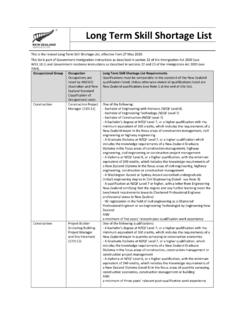Transcription of Science Technology Engineering and Mathematics STEM ...
1 BUREAU OF LABOR STATISTICSS potlight on StatisticsPage 1 JANUARY 2017 STEM Occupations: Past, Present, And FutureStella Fayer, Alan Lacey, and Audrey WatsonNot that long ago, if you were planning a trip to another country, you would probably go to the library to do some research, pick up a foreign phrasebook, and go to the travel agent to book your flight and a hotel. But now, all you have to do is reach for a smart phone. We made just a short leap in time, but an enormous leap in technological advances. Today, it would be difficult to imagine our daily lives without smart phones, applications ( apps ), online shopping, and many other conveniences made possible by the men and women working in Science , Technology , Engineering , and Mathematics (STEM) occupations.
2 This Spotlight on Statistics uses data from Occupational Employment Statistics and Employment Projections to take a closer look at STEM occupations. BUREAU OF LABOR STATISTICSS potlight on StatisticsPage 2 Nearly million STEM jobs in 2015 There were nearly million STEM jobs in May 2015, representing percent of employment. Computer occupations made up nearly 45 percent of STEM employment, and engineers made up an additional 19 percent. Mathematical Science occupations and architects, surveyors, and cartographers combined made up less than 4 percent of STEM employment.
3 BUREAU OF LABOR STATISTICSS potlight on StatisticsPage 3 Seven out of the ten largest STEM occupations were computer relatedMost of the largest STEM occupations were related to computers and information systems. With employment of nearly 750,000, applications software developers was the largest STEM occupation. Computer user support specialists and computer systems analysts each accounted for over a half a million jobs. Wholesale and manufacturing sales representatives of technical and scientific products (334,010) was the largest STEM occupation not related to computers.
4 Mechanical engineers and civil engineers, also non-computer-related STEM occupations, each accounted for over a quarter of a million jobs. But not all STEM occupations were large. Some were among the smallest occupations in the country, including mathematical technicians, with only 820 jobs. Astronomers, postsecondary teachers of forestry and conservation Science , and mathematical Science occupations, all other, each had employment of less than 2,000. BUREAU OF LABOR STATISTICSS potlight on StatisticsPage 4 BUREAU OF LABOR STATISTICSS potlight on StatisticsPage 5 BUREAU OF LABOR STATISTICSS potlight on StatisticsPage 6 Ninety-three out of 100 STEM occupations had wages above the national averageWages for STEM occupations varied vastly.
5 The national average wage for all STEM occupations was $87,570, nearly double the national average wage for non-STEM occupations ($45,700). Ninety-three out of 100 STEM occupations had wages significantly above the national average wage for all occupations of $48,320. Petroleum engineers was the highest paid STEM occupation, with an annual mean wage of $149,590, over $100,000 higher than the national average across all occupations. Physicists ($118,500) was also among the highest paid STEM occupations. Seven STEM occupations had annual mean wages near or below the national average.
6 Environmental Science and protection technicians, including health, and biological technicians had mean wages of $46,540 and $45,230, respectively. Agricultural and food Science technicians and forest and conservation technicians each earned below $40,000 per year on average. BUREAU OF LABOR STATISTICSS potlight on StatisticsPage 7 STEM occupations had above-average growthEmployment in STEM occupations grew by percent, or 817,260 jobs, between May 2009 and May 2015, compared with percent net growth in non-STEM occupations. Computer occupations and engineers were among the types of STEM occupations with the highest job gains.
7 Employment in computer occupations was nearly million in May 2009 and nearly million in May 2015. Employment of engineers was nearly million in May 2009, compared with over million in May 2015. Some STEM occupations lost jobs. In 2009, there were nearly 478,000 jobs in STEM-related sales occupations, compared with approximately 406,000 in 2015. BUREAU OF LABOR STATISTICSS potlight on StatisticsPage 8 BUREAU OF LABOR STATISTICSS potlight on StatisticsPage 9 BUREAU OF LABOR STATISTICSS potlight on StatisticsPage 10 Projected growth rates for types of STEM occupationsThe STEM group that is projected to grow fastest from 2014 to 2024 is the mathematical Science occupations group at percent, compared with the average projected growth for all occupations of percent.
8 This group includes occupations such as statisticians and mathematicians. Since this group has the lowest employment among the STEM groups in 2014, this growth will result in only about 42,900 new jobs over the period. The only STEM group that is projected to show little or no change is drafters, Engineering technicians, and mapping technicians, with a slight projected decline of percent, a decline of about 9,600 jobs. BUREAU OF LABOR STATISTICSS potlight on StatisticsPage 11 Projected new jobs for types of STEM occupationsEmployment in computer occupations is projected to increase by percent from 2014 to 2024, and due to its large employment size, this growth is expected to result in nearly half a million new jobs, far more than any other STEM group.
9 The group projected to add the second largest number of new jobs from 2014 to 2024 is Engineering occupations, with 65,000 new jobs. BUREAU OF LABOR STATISTICSS potlight on StatisticsPage 12 Projected job openings for types of STEM occupationsJob openings show the combination of new jobs and jobs expected to result from workers permanently leaving occupations and needing to be replaced. The computer occupational group is projected to yield over 1 million job openings from 2014 to 2024. The smallest number of job openings projected are in the architects, surveyors, and cartographers group, at only 52,500 projected openings.
10 BUREAU OF LABOR STATISTICSS potlight on StatisticsPage 13 STEM occupations had high educational requirementsOver 99 percent of STEM employment was in occupations that typically require some type of postsecondary education for entry, compared with 36 percent of overall employment. Occupations that typically require a bachelor s degree for entry, like software developers and engineers, made up 73 percent of STEM employment, but only 21 percent of overall employment. Over half of the remaining STEM employment was in occupations that typically require an associate s degree for entry, like web developers and Engineering technicians.














